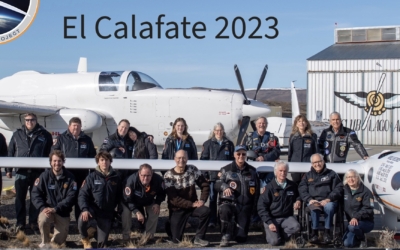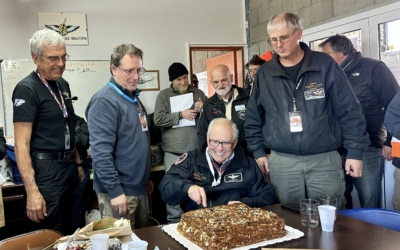On September 3, 2017 Airbus Perlan Mission II became a testament to what a volunteer team can accomplish. Perlan 2 flown by Jim Payne and Morgan Sandercock clawed their way to 52,172 feet GPS altitude with tenacious flying and strong support from the ground crew. The forecast was for soft wave below 18,000 feet then slightly better wave with another difficult transition at 34,000 feet – if you could get there. Doesn’t sound much like a world record forecast, huh?
But the Perlan team was lively at the early breakfast and the 6 person advance balloon team was on the road at 6 am. Michael, Lars, and Daniel with Pedro to video went 45 km away to Punta Bandera. Stewart, Loris, and Sandra headed the opposite direction 20 km to the hangar. The weather balloon confirmed the mediocre forecast. The rest of the team departed the Santa Monica Cabins arriving at the airport in the dark around 7 am. What is remarkable is it was flight #38 of Perlan 2. Just imagine attempting a world record in a unique one-of a-kind aircraft on its 38th flight with an electic volunteer group of dedicated aviation pioneers. Truly the right stuff.
We pushed the Perlan 2 out of hangar into -4 C air with our Clouddancer covers on due to the cold. The sun was barely up and the sky did not show much sign of promise of wave. Michael was standing by for any needed help with language translations on the radio. Stewart, Lars, Tim, Daniel, Loris, Linda, Tago and Jackie got Jim and Morgan belted in and tested pressurizaton the ramp. Jim and Morgan launched behind Cholo in the CNVVM tow plane at just after 9 am to be before a Aerolineas landing. The surface winds were barely from the east and the commercial airplane landed on runway 7. We prefer brisk winds from the west; were we really launching a wave mission?
Cholo towed them to a hot spot near Cero Buenos Aires. Perlan 2 climbed slowly through 18,000 feet and connected with mid level wave. The air was drier than typical so the clouds were much thinner, or the sky was blue. All systems were in the green on the Life Support Systems Display so they kept on flying. At 28,000 feet they had enough altitude to penetrate upwind through sink to the stronger lift of the primary wave off the Andes. That cost 7,000 feet of altitude, but it was an investment towards the forecasted stronger lift.
CapComm with Ed, Tim, Al, Lars and Loris scoured the weather forecasts to find a stairstep path that would enable them to climb higher. We kept looking at the sky wondering where were the wave clouds? Jackie shared the photos and fed information into our Twitter account managed by Suzanne. Loris monitored the thousands of viewers on Virtual Cockpit. Both Weather Extreme and SkySight were actively helping on Sunday of Labor Day weekend. Talk about a fantastic team!
Jim and Morgan connected with the primary, with a decent climb to 33,000 feet. There’s a photo where Perlan 2 had re-climbed to 29,000 feet in the primary and was looking down at flat clouds which indicated laminar flow over the Andes. No previous look at cloud tops had shown the smooth indication of wave. Near the tropopause the lift again softened, and they performed some test points at 35,000 feet. Afterwards they managed a very weak climb to 37,000 feet. As they slowly climbed they knew they had punched through the tropopause when it stopped getting colder and lift again increased. Coldest temp was -68 C or -90 F. That altitude was used to go south towards the border where they were in contact with Chilean air traffic control. They had to stay above 38,000 feet for 40 minutes due to jet traffic headed to Antartica. They performed another flutter vibration test at 40,000 feet. Each time there were no anomolies so Perlan 2 was cleared for another 5,000 feet.
Then it was time to turn downwind to see if they could find the now stronger secondary wave. The battery was working hard keeping critcal items like the oxygen regulator and 20 toes warm. The Virtual Cockpit shows the moving map and several telemetry items like battery, oxygen, and air remaining. As Jim climbed through 42,200 feet Einar sent a message of congratulations which we relayed to Jim on the radio. That had been Jim’s previous highest point back in 1986. (Can you believe Einar remembered? What a gentleman.) They performed another flutter vibration test at 45,000 feet. As they clawed their way above 47,000 feet Jim said he finally realized they might actually top the old record of 50,722 feet (pressure altitude). From 40,000 feet to 50,000 feet Perlan 2 averaged a 3 knot climb rate. Due to new rules the target altitude was 51,214 feet in GPS altitude. (Pressure altitude is no longer used above 15,000 meters. ) But with the morning balloon data Jim knew he would need almost 2,000 more feet of pressure altitude to meet the target in GPS altitude.
The excitement was building as the record altitude became nearer. Morgan took some photos out the window to the east and of the rear instrument panel. Jim keyed the radio with a count down; “10 meters, 6 meters, 2 meters, SCORE!” They topped out at 54,000 feet (pressure altitude) on the cockpit instruments and Morgan flew while Jim took some photos from the top. The front left eyeball is completely frosted over and the right side has frost crystals on upper half. The view out the side window shows the laminar flow to the west and a ragged foehn gap. The maximum GPS altitude was 52,172 feet which was about 1,000 feet above the necessary altitude for a new record. Flight #38 was the longest (6.6 hours), coldest, and highest that Perlan 2 has flown.
They flew some more test points on the way down and waited for several commercial airliners to depart. Jim prefers to land after commercial traffic to be out of their way. If you look closely at the photos of plane on the runway after landing you might spot our one glitch of the day. Upon touching down with a typical gentle landing Jim immediately realized the tire had gone flat. Even though we had seen -60C, the -68 C was the coldest we had seen. The tire held air after a quick fill by London Supply airport maintence. There was no damage to the wheel fairing or to the tire itself after a close inspection. We are investigating some possible changes.
The champagne was waiting when they returned to the hangar. We called Einar on the phone to thank him for his vision. And there was more celebration at dinner. Jim says Perlan 2 flies better above 40,000 feet than below. Thank you for reading the blog and supporting Perlan Project. Hopefully you have enjoyed the adventure and learned something from our activities. There are links to videos and tail camera photos in a separate blog. The flight log can be found at
https://www.onlinecontest.org/olc-2.0/gliding/flightinfo.html?dsId=6116604
Perlan Soars High! Perlan Se Eleva Alto! Jackie




